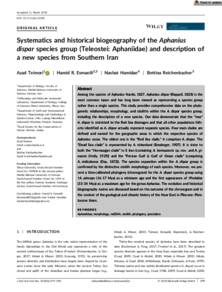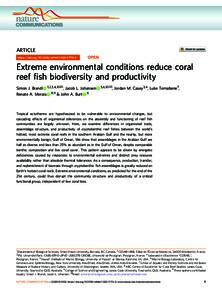وثيقة
Abnormal otoliths in the marine fishes collected from the Persian Gulf and the Gulf of Oman.
المعرف
DOI: 10.3750/AIEP/02350
المصدر
Acta Ichthyologica et Piscatoria. v. 48, 2, p. 143-151
المساهمون
الدولة
Poland
مكان النشر
Szczecin
الناشر
Scientific Society of Szczecin.
ميلادي
2018-01-01
اللغة
الأنجليزية
الملخص الإنجليزي
Background. Although several researchers have examined otoliths of marine fishes from the Persian Gulf and the Gulf of Oman, none has reported abnormalities. A recent effort to identify stocks of marine fishes of the Persian Gulf and the Gulf of Oman revealed that several species have abnormal otoliths. This is the first study reporting and describing the occurrence of abnormal otoliths from the fishes collected from the Persian Gulf and the Gulf of Oman. Material and methods. A total of 225 fish specimens belong to 83 species and 33 families were randomly sampled from the Persian Gulf and the Gulf of Oman. The standard lengths (SL) were measured to the nearest 0.5 mm. The otoliths were extracted, cleaned, and described following available literature. The specimens and their otoliths were deposited in the Zoological Museum at Shahid Bahonar University of Kerman (ZM-SBUK). Results. Among the studied 83 species, we found six species having abnormal otoliths (4.8% of the studied specimens). They belong to six families; Carangidae, Chanidae, Chirocentridae, Leiognathidae, Paralichthyidae, and Sparidae. The number of specimens with abnormal otoliths only in one side (either right or left side) was six, and those with abnormal otoliths in both sides was five. The left otoliths presented more extreme changes than the right. The observed abnormalities can be classified into three types; asteriscus attached to sagittal (the most common); otoliths with a more translucent or crystalline appearance in surface or outlines; and those with an abnormality in their sulcus region. Conclusions. Ecologically, the Persian Gulf is an environment having various kinds of stresses such as salinity fluctuation, acidification, and the water temperature. Such stressors probably affect otolith formation during the larval stages of these fishes and are responsible for the observed abnormalities.
ISSN
0137-1592
قالب العنصر
مقالات الدوريات




